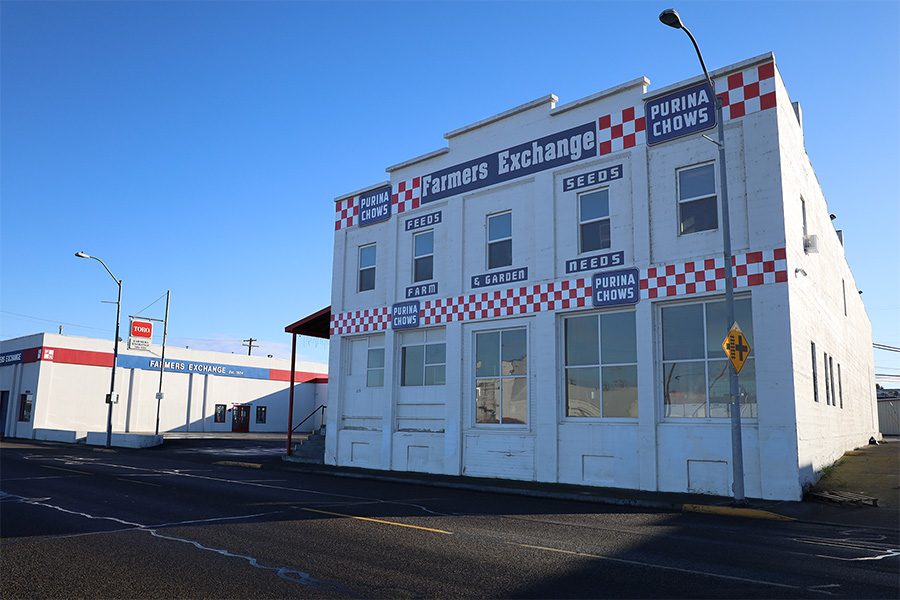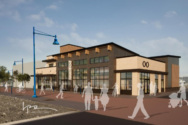
Home » Downtown Kennewick buildings eligible for historic designation span a variety of styles
Architectural heritage
Downtown Kennewick buildings eligible for historic designation span a variety of styles

While downtown Kennewick doesn’t qualify as a national historic district, individual buildings can still apply for the national register. The Farmers Exchange building at 215 W. Canal Drive is currently going through the process and would be Kennewick’s first building on the national register.
Photo by Nathan FinkeJanuary 16, 2025
Though downtown Kennewick doesn’t qualify for a National Register of Historic Places historic district designation, several of its buildings are eligible for the register.
Fifteen downtown Kennewick buildings – ranging in style from classical revival to neo-expressionism – are eligible for the national or local historic register – and a 115-year-old one is currently under consideration for the historic honor.
Eligible buildings
A recent historic resources survey was conducted in the hope of creating a national historic district for the downtown area focused generally along Kennewick Avenue from Dayton Street east to Washington Street.
But the state determined that there wasn’t enough architectural integrity to establish a historic downtown district. This means that officials found a high frequency of building alterations.
The firm conducting the survey was enthusiastic about downtown Kennewick’s size and layers of changes. And the firm believes a historic district designation is possible in the future, according to the report.
Currently, one building in Kennewick is under consideration for the national register.
The city’s Historic Preservation Commission is working to get the Farmers Exchange building at 215 W. Canal Drive, built in 1910, listed on the national register.
The Farmers Exchange store opened in 1924 as a farm and feed shop and closed in July 2024, a casualty of inflation and rising costs.
The commission recently wrapped up the nomination, funded through a Benton County grant. Now, the nomination is in the state’s hands.
If eligible, the National Park Service will list the building, and it would be the first in Kennewick to be listed on the national register.
Applying to be on the national register can be a process that costs money and time, and requires working with an accredited consultant, but listed buildings have opportunities for grant money and tax credits, said Stephanie Button, executive director for the Historic Downtown Kennewick Partnership.
“Our challenge and opportunity is to educate those property owners and give them information that they need to make the decision if they’d like to pursue a local or national listing,” she said.
The survey also provided an opportunity to learn more about Kennewick’s history and better educate property owners and the public.
“We were impressed by all the commercial buildings that still remain there, and we were really impressed with the level of commercial activity, all the different shops, and the variety of shops that are in there,” said Spencer Howard, co-founder of Northwest Vernacular, the historic preservation firm that conducted the survey.

Seeking to register a building for either the national or local historic register is up to the property owner. The church at 201 S. Auburn St. is eligible for both registers.
| Photo by Nathan FinkeHistoric resources survey
More than a year ago, Button had the idea to pursue a historic district in downtown Kennewick, said Matt Halitsky, a senior planner with the city of Kennewick and the staff person for the city’s Historic Preservation Commission.
The commission focuses on public education and promoting historic preservation. Through a grant from the National Park Service, the commission hired Northwest Vernacular to assess the downtown area.
The firm’s work started with months of research, pulling data from Geographic Information Systems, public information from the city and county, the state database WISAARD, and even fire insurance maps from the Library of Congress.
They overlaid various maps and worked to split out the individual buildings, trying to determine when they were built and what their attributes are, Howard said. Buildings constructed less than 45 or 50 years ago were excluded from consideration.
Once the preliminary research was done, Northwest Vernacular spent two days in the field, taking photos of each commercial building and recording information about historic use, current use, architectural style, changes that have been made and more.
All of these are important factors when considering eligibility for a designation. Writing up an eligibility analysis is part of Northwest Vernacular’s work after coming back from the field, along with downloading the data and going through public meetings and state review.
“To be even considered for eligibility, typically a property has to retain some level of architectural integrity,” Howard said. “… So basically, if it was a warehouse, it needs to kind of look like a warehouse.”
National and local registers
Registering the buildings, whether residential or commercial, is the decision of the property owner.
One of the benefits of a national listing is a historic easement, an agreement in which the owner retains ownership and the ability to make changes, but the façade is preserved, Button said.
Buildings listed locally aren’t eligible for a tax credit, Halitsky said, but a special valuation is offered. He explained that it’s a 10-year freeze on increases to the property tax.
The Historic Preservation Commission handles applications for the local register and reviews nominations for the national register. Once a building is listed locally, the commission reviews changes to the exterior of that building as well as any request to demolish it.
Next steps
Despite Kennewick’s ineligibility as a national historic district, the historic resources survey promises to be a useful tool. And it doesn’t rule out a future designation, according to the report.
“That’s the great thing about history, is that the buildings just keep getting older,” Button said. “So if we’re not eligible now, maybe in 10 years we might have a better chance of eligibility if we’re able to retain our historic integrity.”
In the meantime, the survey “helps us with our storytelling, and it helps us with our resource gathering,” she said.
And Northwest Vernacular’s work with Kennewick isn’t over.
The Historic Preservation Commission decided to create a historic context statement backed by further research into the city’s history and development patterns.
The context statement also will be represented visually as a story map so visitors to Kennewick’s website can explore the city’s history.
The commission’s next regular meeting, open to the public, is at 4:30 p.m. Jan. 21 at Kennewick City Hall.
Howard will call in to review the historic context statements and story maps the firm’s done for other communities, like Walla Walla, Halitsky said.
Latest News Local News Architecture & Engineering
KEYWORDS January 2025
Related Articles
Related Products




